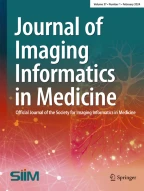Abstract
In recent years, notable progress has been made on standardization of medical image presentations in the definition and implementation of the Digital Imaging and Communications in Medicine (DICOM) Grayscale Standard Display Function (GSDF). In parallel, the American Association of Physicists in Medicine (AAPM) Task Group 18 has provided much needed guidelines and tools for visual and quantitative assessment of medical display quality. In spite of these advances, however, there are still notable gaps in the effectiveness of DICOM GSDF to assure consistent and high-quality display of medical images. In additions the degree of correlation between display technical data and diagnostic usability and performance of displays remains unclear. This article proposes three specific steps that DICOM, AAPM, and ACR may collectively take to bridge the gap between technical performance and clinical use: (1) DICOM does not provide means and acceptance criteria to evaluate the conformance of a display device to GSDF or to address other image quality characteristics. DICOM can expand beyond luminance response, extending the measurable, quantifiable elements of TG18 such as reflection and resolution. (2) In a large picture archiving and communication system (PACS) installation, it is critical to continually track the appropriate use and performance of multiple display devices. DICOM may help with this task by adding a Device Service Class to the standard to provide for communication and control of image quality parameters between applications and devices, (3) The question of clinical significance of image quality metrics has rarely been addressed by prior efforts. In cooperation with AAPM, the American College of Radiology (ACR), and the Society for Computer Applications in Radiology (SCAR), DICOM may help to initiate research that will determine the clinical consequence of variations in image quality metrics (eg, GSDF conformance) and to define what constitutes image quality from a diagnostic perspective. Implementation of these three initiatives may further the reach and impact of DICOM toward quality medicine.
Similar content being viewed by others
Explore related subjects
Discover the latest articles, news and stories from top researchers in related subjects.References
InstitutionalAuthorNameNEMA-PS3.14 (2000) Digital Imaging and Communications in Medicine (DICOM) Part 14: Grayscale Standard Display Function National Electrical Manufacturers Association (NEMA) Rosslyn, VA
Consistent Presentation of Images (CPI) – IHE Radiology Technical Framework, Vol I and Vol II, Revision 5.5, HIMSS/RSNA, 2003 (http://www.rsna.org/IHE/tf/ihe_tf_index.shtml)
Samei E, Badano A, Chakraborty DP, et al. Assessment of Display Performance for Medical Imaging Systems. American Association of Physicists in Medicine (AAPM) Task Group 18, 2004 (http://deckard.duhs.duke.edu/tg 18)
InstitutionalAuthorNameSMPTE-RP133 (1991) Specifications for Medical Diagnostic Imaging Test Pattern for Television Monitors and Hardcopy Recording Cameras Society of Motion Picture & Television Engineers (SMPTE) White Plains, NY
Author information
Authors and Affiliations
Corresponding author
Additional information
Originally printed at the DICOM 20th Anniversary Conference, Baltimore, MD, Sept. 2003.
Rights and permissions
About this article
Cite this article
Samei, E., Rowberg, A., Avraham, E. et al. Toward Clinically Relevant Standardization of Image Quality. J Digit Imaging 17, 271–278 (2004). https://doi.org/10.1007/s10278-004-1031-5
Published:
Issue Date:
DOI: https://doi.org/10.1007/s10278-004-1031-5
